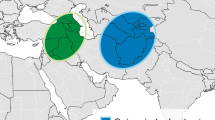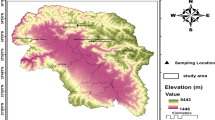Abstract
The objective of this study was to quantify the molecular diversity and to determine the genetic relationships among Secale spp. and among cultivars of Secale cereale using RAPDs, ISSRs and sequence analysis of six exons of ScMATE1 gene. Thirteen ryes (cultivated and wild) were genotyped using 21 RAPD and 16 ISSR primers. A total of 435 markers (242 RAPDs and 193 ISSRs) were obtained, with 293 being polymorphic (146 RAPDs and 147 ISSRs). Two RAPD and nine ISSR primers generated more than 80% of polymorphism. The ISSR markers were more polymorphic and informative than RAPDs. Further, 69% of the ISSR primers selected achieved at least 70% of DNA polymorphism. The study of six exons of the ScMATE1 gene also demonstrated a high genetic variability that subsists in Secale genus. One difference observed in exon 1 sequences from S. vavilovii seems to be correlated with Al sensitivity in this species. The genetic relationships obtained using RAPDs, ISSRs and exons of ScMATE1 gene were similar. S. ancestrale, S. kuprijanovii and S. cereale were grouped in the same cluster and S. segetale was in another cluster. S. vavilovii showed evidences of not being clearly an isolate species and having great intraspecific differences.


Similar content being viewed by others
References
Achrem M., Kalinka A. and Rogalska S. M. 2014 Assessment of genetic relationships among Secale taxa by using ISSR and IRAP markers and the chromosomal distribution of the ACC microsatellite sequence. Turk. J. Bot. 38, 213– 225.
Bolibok H., Rakoczy-Trojanowska M., Hromada A. and Pietrzykowsky R. 2005 Efficiency of different PCR-based marker systems in assessing genetic diversity among winter rye (Secale cereale L.) inbred lines. Euphytica 146, 109–116.
Bolibok-Brȧgoszewska H., Heller-Uszyńska K., Wenzl P, Uszyński G., Kilian A. and Rakoczy-Trojanowska M. 2009 DArT markers for the rye genome—genetic diversity and mapping. BMC Genomics 10, 578.
Bushuk W. 2001 Rye production and uses worldwide. Cereal Foods World 46, 70–73.
Chikmawati T., Skovmand B. and Gustafson J. P. 2005 Phylogenetic relationships among Secale species revealed by amplified fragment length polymorphisms. Genome 48, 792–801.
Chikmawati T., Miftahudin M., Skovmand B. and Gustafson J. P. 2012 Amplified fragment length polymorphism-based genetic diversity among cultivated and weedy rye (Secale cereale L.) accessions. Genet. Resour. Crop Evol. 59, 1743–1752.
Cuadrado A. and Jouve N. 2002 Evolutionary trends of different repetitive DNA sequences during speciation in the genus Secale. J. Hered. 93, 339–345.
De Bustos A. and Jouve N. 2002 Phylogenetic relationship of genus Secale based on the characterization of rDNA ITS sequences. Plant Syst. Evol. 235, 147–154.
Dedio W., Kaltsikes P. J. and Larter E. N. 1969 Numerical chemotaxonomy in the genus Secale. Can. J. Bot. 47, 1175– 1180.
Fernández M. E., Figueiras A. M. and Benito C. 2002 The use of ISSR and RAPD markers for detecting DNA polymorphism, genotype identification and genetic diversity among barley cultivars with known origin. Theor. Appl. Genet. 104, 845–851.
Frederiksen S. and Petersen G. 1998 A taxonomic revision of the genus Secale (Triticeae; Poaceae). Nord. J. Bot. 18, 399–420.
Fu S., Tang Z., Ren Z., Zhang H. and Yan B. 2010 Isolation of rye-specific DNA fragment and genetic diversity analysis of rye Secale L. using wheat SSR markers. J. Genet. 89, 489–492.
Jenabi T., Saeidi H. and Rahiminejad R. M. 2011 Biodiversity of Secale strictum in Iran measured using microsatellites. Genet. Resour. Crop Evol. 58, 497–505.
Jones R. N., González-Sánchez M., González-García M., Vega J. M. and Puertas M. J. 2008 Chromosomes with a life of their own. Cytogenet. Genome Res. 120, 265–280.
Khush G. S. 1962 Cytogenetic and evolutionary studies in Secale II. Interrelationships in the wild species. Evolution 16, 484–496.
Librado P. and Rozas J. 2009 DnaSP v5: a software for comprehensive analysis of DNA polymorphism data. Bioinformatics 25, 1451–1452.
Loarce Y., Gallego R. and Ferrer E. 1996 A comparative analysis of genetic relationships between rye cultivars using RFLP and RAPD markers. Euphytica 88, 107–115.
Ma J. F., Nagao K., Sato K., Ito H., Furukawa J. and Takeda K. 2004 Molecular mapping of a gene responsible for Al-activated secretion of citrate in barley. J. Exp. Bot. 55, 1335–1341.
Mantel N. 1967 The detection of disease clustering and a generalized regression approach. Cancer Res. 27, 209–220.
Matos M., Pinto-Carnide O. and Benito C. 2001 Phylogenetic relationships among Portuguese rye based on isozyme, RAPD and ISSR markers. Hereditas 134, 229–236.
Michelmore R. W., Paran I. and Kesseli R. V. 1991 Identification of markers linked to disease resistance genes by bulk segregant analysis: a rapid method to detect markers in specific genomic regions using segregating populations. Proc. Natl. Acad. Sci.USA 88, 9828–9832.
Nei M. and Li W. H. 1979 Mathematical model for studying genetic variation in terms of restriction endonucleases. Proc. Natl. Acad. Sci. USA 76, 5269–5273.
Prevost A. and Wilkinson M. J. 1999 A new system of comparing PCR primers applied to ISSR fingerprinting of potato cultivars. Theor. Appl. Genet. 98, 107–112.
Raina S. N., Rani V., Kojima T., Ogihara Y., Singh K. P. and Devarumath R. M. 2001 RAPD and ISSR fingerprints as useful genetic markers for analysis of genetic diversity, varietal identification, and phylogenetic relationships in peanut (Arachis hypogaea) cultivars and wild species. Genome 44, 763–772.
Ren T. H., Chen F., Zou Y. T., Jia Y. H., Zhang H. Q., Yan B. J. and Ren Z. L. 2011 Evolutionary trends of microsatellites during the speciation process and phylogenetic relationships within the genus Secale. Genome 54, 316–326.
Rohlf M. 1998 NTSYS-pc. Numerical taxonomy and multivariate analysis system, version 2.02i. Department of Ecology and Evolution. State University of New York, Setauket, USA.
Roldán-Ruiz I., Dendauw J., Van Bockstaele E., Depicker A. and De Loose M. 2000 AFLP markers reveal high polymorphic rates in ryegrass (Lolium spp.) Mol. Breed. 6, 125– 134.
Sencer H. A. and Hawkes J. G. 1980 On the origin of cultivated rye. Biol. J. Linn. Soc. 13, 299–313.
Shang H. Y., Wei Y. M., Wang X. R. and Zheng Y. L. 2006 Genetic diversity and phylogenetic relationships in the rye genus Secale L. (rye) based on Secale cereale microsatellite markers. Genet. Mol. Biol. 29, 685–691.
Silva-Navas J., Benito C., Téllez-Robledo B., El-Moneim D. A. and Gallego F. J. 2012 The ScAACT1 gene at the Q a l t5 locus as a candidate for increased aluminum tolerance in rye (Secale cereale L.) Mol. Breed. 30, 845–856.
Sorkheh K., Shiran B., Gradziel T. M., Epperson B. K., Martíne-Gómez P. and Asadi E. 2007 Amplified fragment length polymorphism as a tool for molecular characterization of almond germplasm: genetic diversity among cultivated genotypes and related wild species of almond, and its relationships with agronomic traits. Euphytica 156, 327–344.
Srivastava P. P., Vijayan K., Awasthi A. K. and Saratchandra B. 2004 Genetic analysis of Morus alba through RAPD and ISSR markers. Indian J. Biotechnol. 3, 527–532.
Stutz H. C. 1972 On the origin of cultivated rye. Am. J. Bot. 59, 59–70.
Tamura K., Dudley J., Nei M. and Kumar S. 2007 MEGA4: molecular evolutionary genetics analysis (MEGA) software version 4.0. Mol. Biol. Evol. 24, 1596–1599.
Tanyolac B. 2003 Inter-simple sequence repeat (ISSR) and RAPD variation among wild barley (Hordeum. vulgare subsp. spontaneum) populations from west Turkey. Genet. Resour. Crop Evol. 50, 611–614.
Vavilov N. 1926 Studies of the origin of cultivated plants. Bull. Appl. Bot. Genet. Plant Breed. 16, 1–248.
Vences F. J., Vaquero F. and Pérez de la Vega M. 1987 Phylogenetic relationships in Secale (Poaceae): an isozymatic study. Plant Syst. 157, 33–47.
Williams J. G. K., Kubelik A. R., Livak K. J., Rafalski J. A. and Tingey S. V. 1990 DNA polymorphism amplified by arbitrary primers are useful as genetic markers. Nucleic Acids Res. 18, 6531–6535.
Yap I. and Nelson R. J. 1996 Winboot: a program for performing bootstrap analysis of binary data to determine the confidence limits of UPGMA-based dendrograms. IRRI Discussion Paper Series No. 14. International Rice Research Institute, P.O. Box 933, Manila, Philippines.
Zhou J., Yang Z., Li G., Liu C., Tang Z., Zhang Y. and Ren Z. 2010 Diversified chromosomal distribution of tandemly repeated sequences revealed evolutionary trends in Secale (Poaceae). Plant Syst. Evol. 287, 49–56.
Zietkiewicz E., Rafalski A. and Labuda D. 1994 Genome fingerprinting by simple sequence repeat (SSR-An shored) polymerase shine reaction amplification. Genomics 20, 176– 183.
Acknowledgements
This work was supported by Acción Integrada España-Portugal (PT2009-0096 and E-171/10) and PhD grant from Fundação para a Ciência e Tecnologia de Portugal (SFRH/BD/65040/2009).
Author information
Authors and Affiliations
Corresponding author
Additional information
[Santos E., Matos M., Silva P., Figueiras A. M., Benito C. and Pinto-Carnide O. 2016 Molecular diversity and genetic relationships in Secale. J. Genet. 95, xx–xx]
Electronic supplementary material
Below is the link to the electronic supplementary material.
Rights and permissions
About this article
Cite this article
SANTOS, E., MATOS, M., SILVA, P. et al. Molecular diversity and genetic relationships in Secale . J Genet 95, 273–281 (2016). https://doi.org/10.1007/s12041-016-0632-3
Received:
Revised:
Accepted:
Published:
Issue Date:
DOI: https://doi.org/10.1007/s12041-016-0632-3




